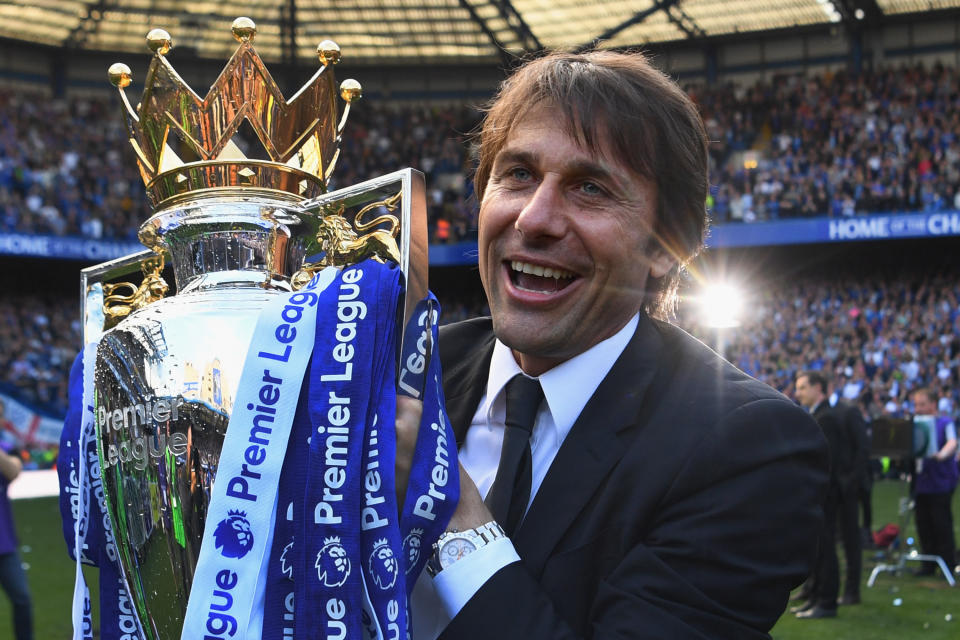Reports: Chelsea sacks Antonio Conte after 2 successful but strange seasons
One year ago, Antonio Conte was a Premier League champion and one of the hottest commodities on the managerial market. A year later, according to widespread reports Thursday, he is without a job.
Chelsea reportedly sacked the Italian manager almost two months after the conclusion of the 2017-18 season, and with less than a month to go until the upcoming campaign.
He’ll reportedly be replaced by another Italian, former Napoli boss Maurizio Sarri. Sarri left the Serie A club at the end of last season after a second-place finish.
Conte departs Stamford Bridge after two successful but tumultuous seasons. It was, seemingly, a mutual split that had been in the offing for months, with Chelsea finally pulling the trigger. And it was the culmination of a strange, strained relationship that neither side tried too hard to maintain.
Why did Chelsea wait until now?
Conte, after some time off, was back in London. He’d been involved in preseason preparations. Now he’s gone. So why now? What took so long?
Chelsea no longer wanted to Conte, nor did Conte want to continue at Chelsea, but the mutuality was precisely the problem. It led to a standoff. If Chelsea sacked Conte, it was (likely) on the hook for the remainder of his contract. If Conte resigned, he forfeited those millions. Each side wanted the other to budge first.

With no natural and open landing spot for a manager of his caliber, Conte never did. “I don’t know. It’s not my decision,” he said of his future after winning the FA Cup in May, effectively telling the club, sack me or risk misery.
He presumably could have carried on into the season, and carried on openly complaining about club executives. That would have done far more damage to Chelsea than to him. So he forced Chelsea’s hand. The Blues must now pay him almost $12 million, essentially to fund a yearlong sabbatical.
Meanwhile, the Blues had picked out their replacement, Sarri. Interestingly, though, they had to negotiate with Napoli and navigate Sarri’s release clause, despite the Italian club having already hired Carlo Ancelotti as Sarri’s replacement. Napoli’s president reportedly wanted the clause ($9.2 million) paid in full. Lawyers were reportedly involved.
The whole situation has been messier than Chelsea would have hoped. But it appears the Premier League club will finally get its business done before heading to the U.S. on its preseason tour.
Who is Maurizio Sarri?
Sarri, 59, was a relative unknown commodity to the casual fan before taking the Napoli job in 2015. He never played professional soccer. His first career was as a banker.
He took up coaching in his 40s, and meandered his way through the Italian lower leagues – from Pescara to Arezzo to Avellino to Hellas Verona to Perugia to Alessandria to Sorrento … you get the point. He never spent two full seasons at a single club.
Then he found his way to Serie B side Empoli in 2012. He came close to promotion in year one, secured it in year two, and impressed in Serie A in year three. Suddenly, he had made a name for himself. Napoli came calling.
Sarri has always played a fast-paced, possession style, which has garnered him praise from both fans and colleagues. His best Napoli teams pressed ravenously and attacked relentlessly in a 4-3-3/4-2-3-1 hybrid, with 5-foot-7 Dries Mertens often as the central striker.
Chelsea’s squad, in many ways, is not equipped to play that style. Sarri and the board will have some work to do to reform it. His deep-lying playmaker extraordinaire, Jorginho, will reportedly follow him to Stamford Bridge if Chelsea forks up more than $60 million. But other reinforcements will be necessary.
Where did it go wrong for Conte?
Conte has never been the most agreeable human being or manager. He craves control. He needs to have things his way. And after winning a Premier League title in his first season, rightly or wrongly, he clearly felt he had earned the right to have things his way.
Chelsea felt differently, and less than a month after lifting the Premier League trophy, there was controversy over a proposed contract extension that had been left unsigned. There were headlines such as “Antonio Conte frustrated over Chelsea transfers.” In June, the Guardian’s Paul MacInnes wrote a piece titled “Why Antonio Conte’s tenacity may become a problem for Chelsea,” and it proved to be prophetic. Conte didn’t get what he wanted, and rather than make concessions, he went on the attack; he became more and more combative.
Conte has always wanted to be the best, not just in a certain soccer sector, but in the world. To bemoan Juventus’ scarce resources relative to European rivals, he used metaphors such as “you do not build skyscrapers with a pail and shovel,” and “they are in a tank, we are a car,” and “you cannot go to eat at a €100 restaurant with just €10 in your pocket.”
He saw a similar narrative developing at Chelsea. He saw a deep-pocketed club making transfer window profits while its competitors shelled out hundreds of millions. He didn’t like that, and decided he’d either force the club to pony up or force his way out. The club never did budge. And Conte’s constant battle with the hierarchy – which he, time after time, took public – made him untenable.
Was Chelsea at fault as well?
It sure was. Chelsea had one of the most brilliant tactical minds in the game at its disposal and under contract. As an institution whose primary goal is to win, it had a duty to try to retain him. Conte initiated the internal bickering. But Chelsea, and its owner – the original sugar-daddy owner, Roman Abramovich – didn’t have to push back. It could have heeded his demands. It could have given him both money and control, and if it had … who knows? Could Chelsea have won a second consecutive Premier League title? Could it be in position to ascend into European soccer’s true top tier?
Alas, probably not. Because there were other factors at play that saw Chelsea take a massive step back in Conte’s second season.
What changed between year 1 and year 2?
Quite simply, Conte’s debut campaign set an unreasonably high bar for success, and thus unreasonable expectations. All signs pointed to regression in year 2 – to a slip down from the 93 points that won the 2016-17 title. Because those 93 points were the result of a perfect storm: no European competition, very few injuries, comparatively little fatigue, good fortune. Underlying numbers suggested Chelsea wasn’t actually the best team in the league last season. And the Premier League has not had a repeat champion this decade. It always seemed unlikely Chelsea would be the first to go back-to-back.
The first brick to fall was Diego Costa, who, according to the man himself, received a text message from Conte telling him he was no longer welcome at Chelsea. Then the club sold Nemanja Matic to Manchester United. Conte was never able to compensate for the two losses. He also made curious tactical decisions himself, deviating from the 3-4-3 that had been so machine-like a year earlier. The players looked drained, perhaps a result of their European travels, perhaps a result of Conte’s wearing, unceasing intensity.
Conte had reportedly been unhappy at the conclusion of his first transfer window at Chelsea either. But he put his frustrations behind him and got to work. Winning, as it so often does, cured all. Conte, rather than complain to the media, set out to prove himself. And he did.
In year two, having assumed the title would give him leverage, he decided to put up a fight. When results dried up, the fight was no longer obscured by the league table. It went public. It culminated in a fifth-place finish, a failure to qualify for the Champions League, and – inevitably, by the time February or March rolled around – the end of an all-too-brief era.
– – – – – – –
Henry Bushnell covers global soccer for Yahoo Sports. Have a tip? Question? Comment? Email him at henrydbushnell@gmail.com, or follow him on Twitter @HenryBushnell, and on Facebook.
World Cup coverage from Yahoo Sports:
• Bushnell: England is out, but also here to stay
• What you need to know about the World Cup final
• Why soccer players flop
• The dark side of Croatian soccer



